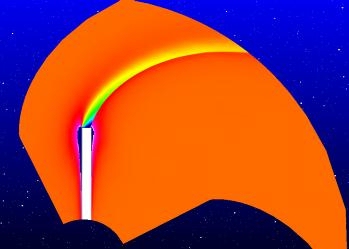DYNAMIC SOLUTION-ADAPTIVE SOLUTION METHODS
FOR PROBLEMS WITH UNSTRUCTURED GRIDS
Rupak Biswas
MRJ
Roger Strawn
US Army Aeroflightdynamics Directorate
NASA Ames Research Center
Moffett Field, CA 94035-1000

Adapted grid and pressure contours near the blade tip for a hovering rotor. The grid is shown in the plane of the rotor and the pressure disturbance from the rotor blade is heard as noise.
Research Objective:
Unstructured grid for solving problems in computational fluid dynamics have two major advantages over their structured-grid counterparts. First, the unstructured mesh allows for fast and efficient grid generation around highly complex geometries. Second, appropriate unstructured-grid data structures facilitate the insertion and deletion of points and enable the computational mesh to locally adapt to the flowfield solution.
This project aims to solve problem in rotary-wing aerodynamics where the rotor blade surface geometries are fairly simple, but the resulting flow features are extremely complex. Details of helicopter rotor wakes and acoustics require highly localized regions of mesh refinement in order to accurately predict rotor airloads, vibrations, and noise. The solution-adaptive capabilities of unstructured grids are very important for these problems.
Approach:
A successful adaptive mesh scheme consists of three components: a flow solver, a strategy for identifying regions for refinement and coarsening, and a mechanism for dynamically altering the mesh. Our flow solver is a version of Timothy Barth's TRI-3D unstructured-grid Euler solver, developed at the NASA Ames Research Center. We currently use fairly simple methods for identifying regions for mesh adaption that are based on first and second derivatives of flowfield quantities. Finally, our mesh adaption data structures are based on edges of tetrahedral or hexahedral grids. Each element is represented by its edges and each edge has a link to the elements that share it. This way, we can rapidly identify the elements to be modified when an edge is inserted or deleted. The regions to be refined are determined by marking the edges of the mesh for subdivision. The refinement procedure for each element is determined from a binary pattern that depends on which of its edges are marked for subdivision. The edge data structures and pattern marking ensure that the refinement and coarsening procedures can be performed efficiently. The resulting mesh adaption code is called 3D_TAG.
Accomplishment Description:
The 3D_TAG mesh adaption scheme has been used to model high-speed impulsive noise for a UH-1H helicopter rotor in hover. A coarse mesh is initially generated and additional points are dynamically added to capture the acoustic wave and the shock near the tip. Mesh coarsening is also used to redistribute existing grid points in a more efficient manner. A total of three refinement levels and two coarsening steps were performed. An error indicator based on acoustic pressure was used to target regions for adaption. Computed results show excellent agreement with experimental microphone data for far-field acoustic pressures. The final mesh refinement step added approximately 70,000 new vertices and required 29 CPU seconds on a Cray C-90 computer. The final mesh contains approximately 140,000 vertices and 865,000 tetrahedra.
Computed pressure field from a hovering rotor that is spinning clockwise. The solution is shown in the plane of the rotor and the pressure disturbance is heard as noise in the far field.
Significance:
Current results demonstrate significant gains in computational efficiency when solution-adaptive methods are compared to their fixed-grid counterparts. These improvements in computational are necessary for future high-fidelity simulations of rotorcraft aerodynamics and acoustics in unsteady environments. One refinement step of the 3D_TAG code requires computer resources that are comparable to one time step for the flow solver. This mesh adaption efficiency is important for later applications to unsteady problems where the mesh adaption will be performed after every few timesteps of the flow solver.
Future Plans:
The 3D_TAG code for tetrahedral meshes has been recently modified to perform refinement and coarsening on hexahedral grid systems. Hexahedral grids are much better suited to anisotropic refinement, which greatly reduces the number of grid points when directional flow features are present. The new hexahedral mesh adaption scheme will soon be tested on 3-D helicopter aerodynamics and acoustics problems.
Related Publications:
Biswas, R., Strawn, R. C., "A Dynamic Mesh Adaption Procedure for Unstructured Hexahedral Grids," AIAA-96-0027, presented at the 34th Aerospace Sciences Meeting, Reno, NV, Jan. 15-18, 1996.
Biswas, R., and Strawn, R. C.,"Mesh Quality Asessment for Multiply-Refined Tetrahedral Grids," presented at the 14th IMACS World Congress, Atlanta, GA, July 11-15, 1994. (see also Applied Numerical Mathematics, Vol. 16, 1996).
Strawn, R. C., Biswas, R., and Garceau, M., "Unstructured Adaptive Mesh Computations of Rotorcraft High-Speed Impulsive Noise," AIAA-93-4359, presented at the AIAA 15th Aeroacoustics Conference, Long Beach, CA, Oct. 1993. (see also Journal of Aircraft, Vol. 32, No. 4, July-August, 1995, pp. 754-760).
Biswas, R., and Strawn, R. C., "A New Procedure for Dynamic Adaption of Three-Dimensional Unstructured Grids," AIAA-93-0672, presented at the AIAA 31th Aerospace Sciences Meeting, Reno, NV, Jan. 11-14, 1993. (see also, Applied Numerical Mathematics, Vol. 13, 1994, pp. 437-452).
Point of Contact:
Roger Strawn
NASA Ames Research Center
Moffett Field CA 94035-1000